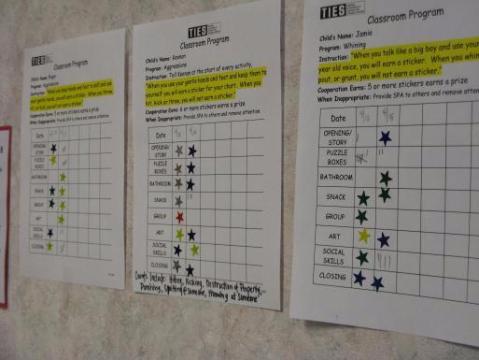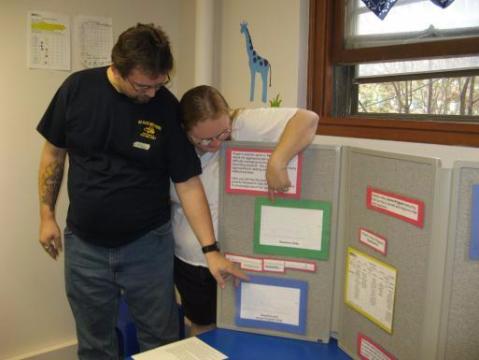Posts Tagged ‘St. Luke’s Hospital’
TIES program encourages positive reinforcement for children with behavior problems
Posted on: May 18, 2009
- In: ADHD | Autism spectrum | Family | Flood of 2008 | Parenting | special education
- 5 Comments
CEDAR RAPIDS — After the Ellis Boulevard home they were renting flooded last June, Patty Blackwell and her family camped and stayed with relatives until they were able to move back.
This disruption in their routine took its toll on the family, especially on Blackwell’s 3-year-old daughter.
“She threw temper tantrums, was non-compliant,” said Blackwell, 46. “I let her walk all over me.”

Charts are kept for each child's progress on specific tasks.
At her wits’ end, Blackwell enrolled her daughter in the TIES program when it first became available in Eastern Iowa in October. TIES, Teaching Interventions to Empower and Strengthen Families, is a proactive parenting program for children under 6 with mild to severe behavior problems.
What makes the program unique, according to program coordinator Craig Meskimen, is that parents and children go through the program together.
Parents are taught eight strategies focusing on positive interaction with the child. The key is telling children what they are doing right rather than what they are doing wrong.
The eight strategies include:
- State expectations in advance.
- Catch your child being good.
- Limited reasonable choices.
- Say “when,” “then.”
- Plan ahead.
- Know what’s reasonable.
- Stay calm.
- Use neutral time.
Blackwell said her daughter is a success story of the program.
“Thank God for this place,” she said at a recent open house at the Resource Center Building on the St. Luke’s Hospital campus, 1026 A Ave. NE.
Blackwell is in the “payback” phase of the program. Funded by a grant through Linn County Community Empowerment, the program is offered at no cost to parents. In return, parents who have completed the program with their children pay back by training new families.
Aaron Jarvis, 31, of Marion, also is a charter parent who is now in the payback program. He was referred to the program by Grant Wood Area Education Agency.
Skeptical at first, he now says he’s a firm believer in the program.
His daughter, now 4, experienced separation issues after her mother left when she was a baby. Her aggressive behavior escalated when she was 3.
“She would scream for two, three hours at a time,” Jarvis said.
He could see a difference in his daughter within three weeks of the program.
“She wanted attention and knew bad behavior worked,” he said.
But parents need to ignore the bad behavior, as long as it’s safe, he said.
“They can get the attention they want by being good.”
With his daughter’s behavior under control, things are less stressful at his house.
“Behavior problems with a child are the last thing you need with the flood and recession,” he said. “You want to be able to go out and have a good time.”
He believes in the program so much he plans to volunteer after his payback time is completed.
“It is so gratifying to see changes in other children,” he said.
He distributes fliers at preschool and day care to spread the word about the program.
The program originated in 1969 in Tennessee to treat children with Down syndrome and those on the autism spectrum. However, Meskimen said there is no minimum or maximum behavior for a child to qualify for the program.
Keith Pitts, 33, of Cedar Rapids, said 90 percent of the program is focused on changing the parent, not the child.
He and his wife, Emily, adopted three children from foster care, making the bond even more difficult from the onset.
His son was diagnosed with attention deficit hyperactivity disorder, and Pitts wanted to try this program before medication.
“He’s an amazingly different kid,” he said.
Ignoring the bad behavior is difficult at first for both the parent and the child, he said.
The child needs to realize that “no matter how I act out, I’m not going to get attention unless I’m being good,” Pitts explained.
Parents need to be consistent with the program’s skills or the information will not be retained, he said.

Kenny and Kim Petersen check out the charts marking their son's progress at home.
Kim Petersen, 32, of Cedar Rapids, came to TIES “pulling my hair out” fighting with her husband, Kenny, about their son’s behavior problems.
“Now he’s done a 360,” she said of her son. “It’s not just us teaching him, he teaches us.”
Parents are encouraged to keep a tally of every time the child does something negative. Parents also are encouraged to be consistent with ignoring bad behavior and recognizing good behavior.
Once the program is completed, the families take the strategies home with a written plan. Andrea Dorn, of the Abbe Center, said the home program is written in three phases. First, the TIES staff writes a home program for the parents, then the parents and staff write a program together. Finally, the parents write their own home program to fit their child’s needs.
Recent Comments